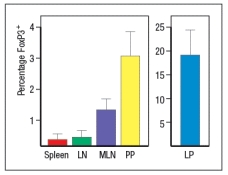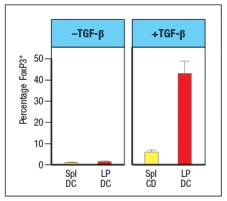Wild-type mice are adoptively transferred with naive CD4 T cells isolated from OT-II T-cell receptor transgenic mice. These OT-II T cells are specific for a peptide of the chicken ovalbumin protein (OVA) bound to MHC class II. After transfer, the OT-II cells rapidly disperse to all of the secondary lymphoid organs in the recipient mice. Half of the recipient mice are then given OVA protein dissolved in their drinking water, and the other half of the mice receive normal drinking water for 5 days. On the following day (day 6), lymphocytes from the spleen, the peripheral lymph nodes (LN), mesenteric lymph nodes (MLN), Peyer's patches (PP) and lamina propria (LP) are isolated and examined for the proportions of CD4 T cells in each organ expressing FoxP3. The results are shown in Figure. 
a) What is the conclusion from this experiment?
To investigate this further, dendritic cells are isolated from the spleen (spl-DC) or from the lamina propria of the small intestine (LP-DC). Each subset of dendritic cells is pulsed with the OVA protein, and then incubated with naive OT-II CD4 T cells for 5 days in the presence or absence of TGF- . The CD4 T cells are then examined for FoxP3 expression; the results are shown in Figure. 
b) Why is TGF- added in this experiment?
c) What is the major difference between the splenic dendritic cells and those isolated from the lamina propria?
The CD4 T cells from the experiment above, in which the T cells were cultured for 5 days with OVA-pulsed splenic or lamina propria dendritic cells in the presence or absence of TGF- , were also assessed for their surface expression of the integrin 4 7.
d) Of the four groups of T cells shown in the graph, which ones would be expected to show high levels of 4 7?
Definitions:
Phases
Different stages or states that a system or process undergoes, often used in the context of matter (solid, liquid, gas) or project milestones.
Generators
Devices that convert mechanical energy into electrical energy for use in an external circuit.
Current Flow
The movement of electric charge carriers, such as electrons, through a conductor or circuit, driven by a potential difference.
Battery Operation
Pertains to the functioning and management of a battery in providing electrical power to devices, vehicles, or systems.
Q10: The immunosuppressive drug rapamycin acts by inhibiting
Q10: NOD proteins are intracellular sensors of infections
Q11: For each of the panels A–D in
Q12: Determine whether or not the function
Q18: During inflammation, some proteins undergo modification,
Q21: The prevention of inflammatory immune responses
Q23: One factor that contributes to the enhanced
Q28: The events on Sept 11, 2001 exerted
Q40: Let f (x) = <span
Q48: Consider the paraboloid <span class="ql-formula"